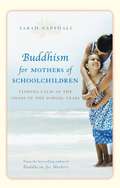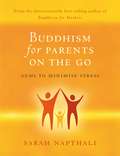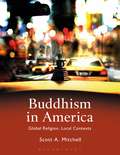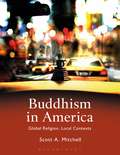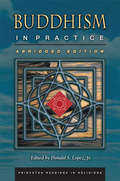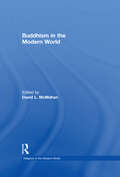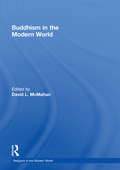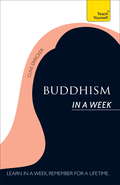- Table View
- List View
Buddhism for Mothers of Schoolchildren: Finding calm in the chaos of the school years
by Sarah NapthaliWith her children at school, a mother is on to a new stage of her life, playing a new role. The daily challenges she confronts have changed, yet for each one Buddhist teachings of mindfulness, compassion and calm are invaluable. This book explores those teachings through many scenarios, including coping with routine and repetition, answering children's tricky questions about how the world works, fitting in with other parents, managing our fears and expectations for our children and dealing with difficult behaviour in both children and adults.
Buddhism for Parents On the Go: Gems to Minimise Stress
by Sarah NapthaliWithin these warm and often funny pages, Buddhist teachings are at their most accessible. Even if exploring Buddhism is not where you thought you'd be right now, read any page of Buddhism for Parents on the Go and think about its relevance to your life. Make space in your busy days to be kinder to yourself. From advice to the sleep deprived to dealing with the drama of toddler tantrums to thoughts on teenage egocentrism, this invaluable book will teach you how to manage the expectations you have of yourself, your partner and your children. Buddhism for Parents On the Go will help you conquer the day-to-day challenges of life, reduce your stress levels and gain true insight into the ever-changing joys of parenthood.
Buddhism Goes to the Movies: Introduction to Buddhist Thought and Practice
by Ronald GreenBuddhism Goes to the Movies: Introduction to Buddhist Thought and Practice explains the basics of Buddhist philosophy and practice through a number of dramatic films from around the world. This book introduces readers in a dynamic way to the major traditions of Buddhism: the Theravāda, and various interrelated Mahāyāna divisions including Zen, Pure Land and Tantric Buddhism. Students can use Ronald Green’s book to gain insights into classic Buddhist themes, including Buddhist awakening, the importance of the theory of dependent origination, the notion of no-self, and Buddhist ideas about life, death and why we are here. Contemporary developments are also explored, including the Socially Engaged Buddhism demonstrated by such figures as the Dalai Lama, Thich Nhat Hanh, Aung San Suu Kyi, and other Buddhist activists. Finally, comparisons between filmic expressions of Buddhism and more traditional artistic expressions of Buddhism—such as mandala drawings—are also drawn. An important addition to any introduction to Buddhist philosophy and practice, Buddhism Goes to the Movies is an excellent way to bring Buddhist thought, history, and activity to the uninitiated and interested reader.
Buddhism Goes to the Movies: Introduction to Buddhist Thought and Practice
by Ronald GreenBuddhism Goes to the Movies: Introduction to Buddhist Thought and Practice explains the basics of Buddhist philosophy and practice through a number of dramatic films from around the world. This book introduces readers in a dynamic way to the major traditions of Buddhism: the Theravāda, and various interrelated Mahāyāna divisions including Zen, Pure Land and Tantric Buddhism. Students can use Ronald Green’s book to gain insights into classic Buddhist themes, including Buddhist awakening, the importance of the theory of dependent origination, the notion of no-self, and Buddhist ideas about life, death and why we are here. Contemporary developments are also explored, including the Socially Engaged Buddhism demonstrated by such figures as the Dalai Lama, Thich Nhat Hanh, Aung San Suu Kyi, and other Buddhist activists. Finally, comparisons between filmic expressions of Buddhism and more traditional artistic expressions of Buddhism—such as mandala drawings—are also drawn. An important addition to any introduction to Buddhist philosophy and practice, Buddhism Goes to the Movies is an excellent way to bring Buddhist thought, history, and activity to the uninitiated and interested reader.
Buddhism in America: Global Religion, Local Contexts
by Scott A. MitchellBuddhism in America provides the most comprehensive and up to date survey of the diverse landscape of US Buddhist traditions, their history and development, and current methodological trends in the study of Buddhism in the West, located within the translocal flow of global Buddhist culture.Divided into three parts (Histories; Traditions; Frames), this introduction traces Buddhism's history and encounter with North American culture, charts the landscape of US Buddhist communities, and engages current methodological and theoretical developments in the field.The volume includes:- A short introduction to Buddhism- A historical survey from the 19th century to the present- Coverage of contemporary US Buddhist communities, including Theravada, Mahayana, and VajrayanaTheoretical and methodological issues and debates covered include:- Social, political and environmental engagement- Race, feminist, and queer theories of Buddhism- Secular Buddhism, digital Buddhism, and modernity - Popular culture, media, and the artsPedagogical tools include chapter summaries, discussion questions, images and maps, a glossary, and case studies. The book's website provides recommended further resources including websites, books and films, organized by chapter. With individual chapters which can stand on their own and be assigned out of sequence, Buddhism in America is the ideal resource for courses on Buddhism in America, American Religious History, and Introduction to Buddhism.
Buddhism in America: Global Religion, Local Contexts
by Scott A. MitchellBuddhism in America provides the most comprehensive and up to date survey of the diverse landscape of US Buddhist traditions, their history and development, and current methodological trends in the study of Buddhism in the West, located within the translocal flow of global Buddhist culture.Divided into three parts (Histories; Traditions; Frames), this introduction traces Buddhism's history and encounter with North American culture, charts the landscape of US Buddhist communities, and engages current methodological and theoretical developments in the field.The volume includes:- A short introduction to Buddhism- A historical survey from the 19th century to the present- Coverage of contemporary US Buddhist communities, including Theravada, Mahayana, and VajrayanaTheoretical and methodological issues and debates covered include:- Social, political and environmental engagement- Race, feminist, and queer theories of Buddhism- Secular Buddhism, digital Buddhism, and modernity - Popular culture, media, and the artsPedagogical tools include chapter summaries, discussion questions, images and maps, a glossary, and case studies. The book's website provides recommended further resources including websites, books and films, organized by chapter. With individual chapters which can stand on their own and be assigned out of sequence, Buddhism in America is the ideal resource for courses on Buddhism in America, American Religious History, and Introduction to Buddhism.
Buddhism in China: A Historical Survey
by Kenneth Kuan Ch'enCONTENTS: Preface. Table of Chinese Dynasties. Maps of Dynasties. Introduction, Growth and Domestication. Maturity and Acceptance. Decline. Conclusion. Glossary. Chinese Names and Titles. Bibliography. Index.
Buddhism in Court: Religion, Law, and Jurisdiction in China
by Cuilan LiuWhat happens to Buddhist monks and nuns who commit crimes? Buddhism in Court is the first book to uncover an important, yet long-overlooked, Buddhist campaign for clerical legal privileges that aim to exempt monks and nuns from being tried and punished in the government courts. Liu reveals the campaign's origins in Indian Buddhism and how Chinese Buddhists' engagement reshaped Buddhism's place in the jurisdictional landscape in China from the fourth century to the present. Drawing on Buddhist monastic law texts, archives, court documents, Chinese laws, official histories, law case books, institutional announcements, and private writings circulated on social media, Buddhism in Court traces the legacy of the campaign for clerical legal privileges from its origin in India to its transformation in China and its continuing impact in the Chinese courtroom to the present day. Diverting from the dynasty-centered approach to studying religion, law, and history in China, Buddhism in Court expands our understanding of this legacy of early Chinese Buddhism and challenges the notion that the transition between imperial and post-imperial China was marked only by disruption.
Buddhism in Court: Religion, Law, and Jurisdiction in China
by Cuilan LiuWhat happens to Buddhist monks and nuns who commit crimes? Buddhism in Court is the first book to uncover an important, yet long-overlooked, Buddhist campaign for clerical legal privileges that aim to exempt monks and nuns from being tried and punished in the government courts. Liu reveals the campaign's origins in Indian Buddhism and how Chinese Buddhists' engagement reshaped Buddhism's place in the jurisdictional landscape in China from the fourth century to the present. Drawing on Buddhist monastic law texts, archives, court documents, Chinese laws, official histories, law case books, institutional announcements, and private writings circulated on social media, Buddhism in Court traces the legacy of the campaign for clerical legal privileges from its origin in India to its transformation in China and its continuing impact in the Chinese courtroom to the present day. Diverting from the dynasty-centered approach to studying religion, law, and history in China, Buddhism in Court expands our understanding of this legacy of early Chinese Buddhism and challenges the notion that the transition between imperial and post-imperial China was marked only by disruption.
Buddhism in Iran: An Anthropological Approach to Traces and Influences
by M. VaziriExploring the interactions of the Buddhist world with the dominant cultures of Iran in pre- and post-Islamic times, Vaziri demonstrates that the traces and cross-influences of Buddhism have brought the material and spiritual culture of Iran to its present state even after the term was eradicated from the literary and popular language of the region.
BUDDHISM IN MONGOLIAN HIST CULT & SOC C
by Vesna A. WallaceBuddhism in Mongolian History, Culture, and Society explores the unique elements of Mongolian Buddhism while challenging its stereotyped image as a mere replica of Tibetan Buddhism. Vesna A. Wallace brings together an interdisciplinary group of leading scholars to explore the interaction between the Mongolian indigenous culture and Buddhism, the features that Buddhism acquired through its adaptation to the Mongolian cultural sphere, and the ways Mongols have constructed their Buddhist identity. The contributors explore the ways that Buddhism retained unique Mongolian features through Qing and Mongol support, and bring to light the ways in which Mongolian Buddhists saw Buddhism as inseparable from "Mongolness." They show that by being greatly supported by Mongol and Qing empires, suppressed by the communist governments, and experiencing revitalization facilitated by democratization and the challenges posed by modernity, Buddhism underwent a series of transformations while retaining unique Mongolian features. The book covers historical events, social and political conditions, and influential personages in Mongolian Buddhism from the sixteenth century to the present, and addresses the artistic and literary expressions of Mongolian Buddhism and various Mongolian Buddhist practices and beliefs.
Buddhism in Mongolian History, Culture, and Society
by Vesna A. WallaceBuddhism in Mongolian History, Culture, and Society explores the unique elements of Mongolian Buddhism while challenging its stereotyped image as a mere replica of Tibetan Buddhism. Vesna A. Wallace brings together an interdisciplinary group of leading scholars to explore the interaction between the Mongolian indigenous culture and Buddhism, the features that Buddhism acquired through its adaptation to the Mongolian cultural sphere, and the ways Mongols have constructed their Buddhist identity. The contributors explore the ways that Buddhism retained unique Mongolian features through Qing and Mongol support, and bring to light the ways in which Mongolian Buddhists saw Buddhism as inseparable from "Mongolness." They show that by being greatly supported by Mongol and Qing empires, suppressed by the communist governments, and experiencing revitalization facilitated by democratization and the challenges posed by modernity, Buddhism underwent a series of transformations while retaining unique Mongolian features. The book covers historical events, social and political conditions, and influential personages in Mongolian Buddhism from the sixteenth century to the present, and addresses the artistic and literary expressions of Mongolian Buddhism and various Mongolian Buddhist practices and beliefs.
Buddhism in Practice: (Abridged Edition)
by Donald S. Lopez Jr.This anthology, first published in 1995, illustrates the vast scope of Buddhist practice in Asia, past and present. Re-released now in a slimmer but still extensive edition, Buddhism in Practice presents a selection of thirty-five translated texts--each preceded by a substantial introduction by its translator. These unusual sources provides the reader with a sense of the remarkable diversity of the practices of persons who over the course of 2,500 years have been identified, by themselves or by others, as Buddhists. Demonstrating the many continuities among the practices of Buddhist cultures widely separated by both history and geography, Buddhism in Practice continues to provide an ideal introduction to Buddhism and a source of new insights for scholars.
Buddhism in Practice: (Abridged Edition) (PDF)
by Donald S. Lopez Jr.This anthology, first published in 1995, illustrates the vast scope of Buddhist practice in Asia, past and present. Re-released now in a slimmer but still extensive edition, Buddhism in Practice presents a selection of thirty-five translated texts--each preceded by a substantial introduction by its translator. These unusual sources provides the reader with a sense of the remarkable diversity of the practices of persons who over the course of 2,500 years have been identified, by themselves or by others, as Buddhists. Demonstrating the many continuities among the practices of Buddhist cultures widely separated by both history and geography, Buddhism in Practice continues to provide an ideal introduction to Buddhism and a source of new insights for scholars.
Buddhism in the Global Eye: Beyond East and West
by John S. Harding Victor Sōgen Hori Alexander SoucyBuddhism in the Global Eye focuses on the importance of a global context and transnational connections for understanding Buddhist modernizing movements. It also explores how Asian agency has been central to the development of modern Buddhism, and provides theoretical reflections that seek to overcome misleading East-West binaries.Using case studies from China, Japan, Vietnam, India, Tibet, Canada, and the USA, the book introduces new research that reveals the permeable nature of certain categories, such as "modern", "global", and "contemporary" Buddhism. In the book, contributors recognize the multiple nodes of intra-Asian and global influence. For example, monks travelled among Asian countries creating networks of information and influence, mutually stimulating each other's modernization movements. The studies demonstrate that in modernization movements, Asian reformers mobilized all available cultural resources both to adapt local forms of Buddhism to a new global context and to shape new foreign concepts to local Asian forms.
Buddhism in the Global Eye: Beyond East and West
Buddhism in the Global Eye focuses on the importance of a global context and transnational connections for understanding Buddhist modernizing movements. It also explores how Asian agency has been central to the development of modern Buddhism, and provides theoretical reflections that seek to overcome misleading East-West binaries.Using case studies from China, Japan, Vietnam, India, Tibet, Canada, and the USA, the book introduces new research that reveals the permeable nature of certain categories, such as "modern", "global", and "contemporary" Buddhism. In the book, contributors recognize the multiple nodes of intra-Asian and global influence. For example, monks travelled among Asian countries creating networks of information and influence, mutually stimulating each other's modernization movements. The studies demonstrate that in modernization movements, Asian reformers mobilized all available cultural resources both to adapt local forms of Buddhism to a new global context and to shape new foreign concepts to local Asian forms.
Buddhism in the Modern World: Adaptations of an Ancient Tradition
by Steven Heine Charles S. PrebishThe history of Buddhism has been characterized by an ongoing tension between attempts to preserve traditional ideals and modes of practice and the need to adapt to changing cultural conditions. Many developments in Buddhist history, such as the infusion of esoteric rituals, the rise of devotionalism and lay movements, and the assimilation of warrior practices, reflect the impact of widespread social changes on traditional religious structures. At the same time, Buddhism has been able to maintain its doctrinal purity to a remarkable degree. This volume explores how traditional Buddhist communities have responded to the challenges of modernity, such as science and technology, colonialism, and globalization. Editors Steven Heine and Charles S. Prebish have commissioned ten essays by leading scholars, each examining a particular traditional Buddhist school in its cultural context. The essays consider how the encounter with modernity has impacted the disciplinary, textual, ritual, devotional, practical, and socio-political traditions of Buddhist thought throughout Asia. Taken together, these essays reveal the diversity and vitality of contemporary Buddhism and offer a wide-ranging look at the way Buddhism interacts with the modern world.
Buddhism in the Modern World
by David L. McMahanBuddhism in the Modern World explores the challenges faced by Buddhism today, the distinctive forms that it has taken and the individuals and movements that have shaped it. Part One discusses the modern history of Buddhism in different geographical regions, from Southeast Asia to North America. Part Two examines key themes including globalization, gender issues, and the ways in which Buddhism has confronted modernity, science, popular culture and national politics. Each chapter is written by a distinguished scholar in the field and includes photographs, summaries, discussion points and suggestions for further reading. The book provides a lively and up-to-date overview that is indispensable for both students and scholars of Buddhism.
Buddhism in the Modern World
by David L. McMahanBuddhism in the Modern World explores the challenges faced by Buddhism today, the distinctive forms that it has taken and the individuals and movements that have shaped it. Part One discusses the modern history of Buddhism in different geographical regions, from Southeast Asia to North America. Part Two examines key themes including globalization, gender issues, and the ways in which Buddhism has confronted modernity, science, popular culture and national politics. Each chapter is written by a distinguished scholar in the field and includes photographs, summaries, discussion points and suggestions for further reading. The book provides a lively and up-to-date overview that is indispensable for both students and scholars of Buddhism.
Buddhism In A Week: Teach Yourself (In A Week)
by Clive ErrickerLearn in a week, remember for a lifetime!In just one week, this accessible book will give you knowledge to last forever. End of chapter summaries and multiple choice questions are all designed to help you test your knowledge and gain confidence. So whether you are a student or you simply want to widen your knowledge, you will find this seven-day course a very memorable introduction.Sunday: Consider what Buddhism is and why it mattersMonday: Learn who the Buddha was and how he livedTuesday: Examine the Buddha's teaching on a wide range of issuesWednesday: Discover the Buddhist scriptures and learn how they are interpreted today.Thursday: Explore meditation and Buddhist devotional practices.Friday: Engage with the ethics of Buddhism, and how Buddhists respond to moral issuesSaturday: Clarify procedures for disciplinary interviews
Buddhism in World Cultures: Comparative Perspectives (Religion in Contemporary Cultures)
by Frank J. Korom Stephen C. BerkwitzA comprehensive overview of modern Buddhism across cultures, showing how this ancient religion has adapted to recent social and political change.Collecting the work of leading authorities on Buddhism in different societies around the world, this book details the state of the religion in Asian countries where it is a major cultural influence and in North America. The religion has changed to meet the challenges of modernity; its practitioners have incorporated those innovations and this work examines those changes in-depth.A comprehensive overview of historical Buddhist practice grounds the reader for the entire nine chapters, each of which is organized by geographical area and follows the path Buddhism took as it spread across Asia and into North America. Each chapter presents field research and critical reflection on what constitutes modern Buddhism in one of nine countries or regions. Histories of Buddhism are common; this is the only source for in-depth information on modern Buddhism.
Buddhism, International Relief Work, and Civil Society (Contemporary Anthropology of Religion)
by Hiroko Kawanami Geoffrey SamuelNatural disasters in Asian countries have brought global attention to the work of local Buddhist communities and groups. Here, the contributors examine local Buddhist communities and international Buddhist organizations engaged in a variety of relief work in countries including India, Thailand, Sri Lanka, China, and Japan.
Buddhism is Not What You Think: Finding Freedom Beyond Beliefs
by Steve HagenWhat is Buddhism? In Buddhism is Not What You Think Steve Hagen, bestselling author of Buddhism Plain and Simple and a Zen priest, cuts through the many misconceptions surrounding Buddhism, and shows us its true purpose. Drawing on down-to-earth examples from everyday life, this practical and straightforward guide penetrates the most essential and enduring questions at the heart of the Buddha's teachings: How can we see the world in each moment, rather than merely as what we think, hope, or fear it is? How can we base our actions on reality? How can we live lives that are wise, compassionate, open and honest? What can it bring to our lives? This book offers a profound and clear path to a life of joy and freedom.
Buddhism, Knowledge and Liberation: A Philosophical Study (Ashgate World Philosophies Series)
by David BurtonBuddhism is essentially a teaching about liberation - from suffering, ignorance, selfishness and continued rebirth. Knowledge of 'the way things really are' is thought by many Buddhists to be vital in bringing about this emancipation. This book is a philosophical study of the notion of liberating knowledge as it occurs in a range of Buddhist sources. Buddhism, Knowledge and Liberation assesses the common Buddhist idea that knowledge of the three characteristics of existence (impermanence, not-self and suffering) is the key to liberation. It argues that this claim must be seen in the context of the Buddhist path and training as a whole. Detailed attention is also given to anti-realist, sceptical and mystical strands within the Buddhist tradition, all of which make distinctive claims about liberating knowledge and the nature of reality. David Burton seeks to uncover various problematic assumptions which underpin the Buddhist worldview. Sensitive to the wide diversity of philosophical perspectives and interpretations that Buddhism has engendered, this book makes a serious contribution to critical and philosophically aware engagement with Buddhist thought. Written in an accessible style, it will be of value to those interested in Buddhist Studies and broader issues in comparative philosophy and religion.
Buddhism, Knowledge and Liberation: A Philosophical Study (Ashgate World Philosophies Series)
by David BurtonBuddhism is essentially a teaching about liberation - from suffering, ignorance, selfishness and continued rebirth. Knowledge of 'the way things really are' is thought by many Buddhists to be vital in bringing about this emancipation. This book is a philosophical study of the notion of liberating knowledge as it occurs in a range of Buddhist sources. Buddhism, Knowledge and Liberation assesses the common Buddhist idea that knowledge of the three characteristics of existence (impermanence, not-self and suffering) is the key to liberation. It argues that this claim must be seen in the context of the Buddhist path and training as a whole. Detailed attention is also given to anti-realist, sceptical and mystical strands within the Buddhist tradition, all of which make distinctive claims about liberating knowledge and the nature of reality. David Burton seeks to uncover various problematic assumptions which underpin the Buddhist worldview. Sensitive to the wide diversity of philosophical perspectives and interpretations that Buddhism has engendered, this book makes a serious contribution to critical and philosophically aware engagement with Buddhist thought. Written in an accessible style, it will be of value to those interested in Buddhist Studies and broader issues in comparative philosophy and religion.
